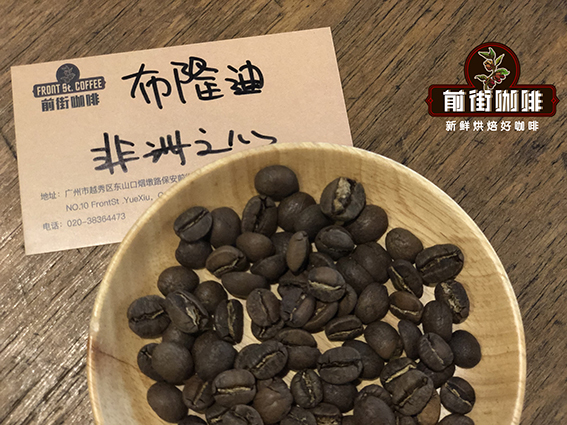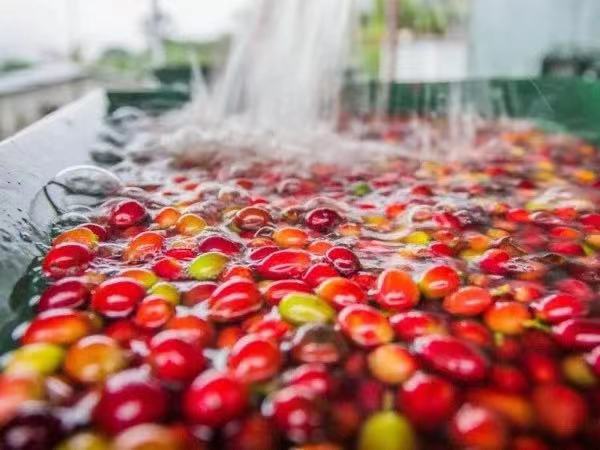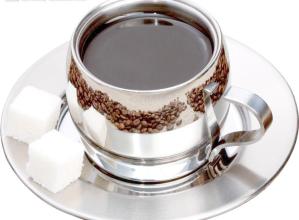Burundian boutique coffee beans flavor and taste characteristics story Burundian bourbon coffee varieties

Professional coffee knowledge exchange more coffee bean information please follow the coffee workshop (Wechat official account cafe_style)
When it comes to African coffee, how can it be less than Burundian Heart of Africa coffee beans? Africa has always been famous for citrus citric acid coffee, and Qianjie coffee beans from Burundi are no exception, but its acid performance is not as fresh and thorough as Ethiopia, nor the mellow juicy feeling of Kenya, but somewhere between these two flavors. Then this article on Qianjie will talk about Burundian Heart of Africa Coffee beans.
Front Street Coffee Burundi Heart of Africa Coffee beans

Country: Burundi
Producing area: Luthona town
Altitude: 1400-1700m
Variety: bourbon
Treatment method: washing treatment method
Flavor: Brin, kumquat, lemon, dried fruit, caramel, tea, sour light
Qianjie has always emphasized in previous articles that the flavor of a high-quality coffee bean depends on the producing area of the coffee fruit, the variety of coffee and the way it is handled.
Burundian coffee producing area

Burundi is a typical landlocked country, and according to Qianjie, Burundi has always been underdeveloped and has even been rated as one of the poorest countries in the world by international organizations, but because of its small size and rolling hilly beauty, it is also the crossroads of Central and East Africa, the watershed between the Nile and the Congo River, and the outline of the country is very much like a heart, so it is called "Heart of Africa". Burundi also because of its unique geographical location and limited national resources, so the country's economic sources come from agriculture and animal husbandry, and the income from coffee cultivation is also the main economic source of their countries.
As mentioned in the previous article on the street, Burundi has rolling hills, so the altitude of Burundi varies greatly, from 700m to 2670m, while coffee beans grown at high altitude have brighter acidity and lemon flavor. At the same time, the climate distribution of Burundi is mainly tropical plateau climate, with a very large temperature difference between day and night, and rich volcanic soil, these conditions are conducive to the growth of coffee trees, which lays a solid tone for the quality of Burundian coffee beans.
And according to Qianjie, because of poverty, there is no coffee farm in Burundi, and its coffee farming is mainly small-scale family agriculture, so the quality of coffee beans in Burundi varies greatly. Years of war and social unrest have also made the coffee farming industry in Burundi very unstable.
Fortunately, since 2008, in order to promote economic development, the Burundian government has begun to transition to the boutique coffee industry, leading to the emergence of a variety of transactions, such as direct trade procurement with traceable origin. That is, similar to the producing area information on the label on the front street coffee package, this traceable coffee bean also makes consumers more secure about the quality of Burundian coffee.
And Burundi also held the prestigious Cup Coffee quality Competition (Prestige Cup) in 2011, which is also a warm-up event before the formal holding of the more large-scale Outstanding Cup Coffee Competition. It is precisely because of this competition that the major coffee washing and processing plants in Burundi began to strictly require their own technology and coffee bean quality, and ranked according to quality, so that they could sell at a good price at a later auction, so these coffee beans have production and marketing experience. This means that high-quality individual coffee beans from Burundi will gradually become active in the coffee market for coffee fans in various countries to taste.
It is precisely because of these opportunities that Qianjie introduced Burundian coffee beans for coffee fans to drink. After all, it also passed the high-quality individual coffee beans recognized by Qianjie baristas. Qianjie believes that its flavor performance is enough to rank in African coffee.
Burundian coffee varieties

When it comes to the varieties of Burundian coffee, it must be traced back to the history of Burundian coffee. Burundian coffee trees were introduced during the Belgian colonization in 1930, and as the previous street article said, the climatic and geographical conditions of Burundi are very suitable for the growth of coffee trees. These colonists found that bourbon coffee trees were the most suitable for growing in Burundi, but later countries signed a peace agreement. Belgian coffee research in Burundi came to an end, and bourbon coffee beans became the only coffee varieties currently grown in Burundi. Next, let's introduce what is bourbon coffee in front of the street.
Bourbon
Bourbon coffee trees were originally planted on the island of Reunion, which was also known as Bourbon before 1789. This is the origin of the bourbon name. according to botanists, it is the second species caused by the mutation of Tippica coffee, and it is also the oldest existing Arabica coffee variety, while it is planted in bourbon at high altitude. it usually has a better aroma, and the acidity is bright, and it even tastes like red wine.
Burundian coffee treatment

According to Qianjie, coffee farmers all over Burundi wash coffee beans. As Qianjie said above, Burundian coffee cultivation patterns are mainly family agriculture, so coffee farmers have to send coffee fruits to special coffee washing plants for treatment, but there are also some coffee farmers who do not believe that coffee farmers will first carry out a hand washing treatment and then give it to the washing factory. At the same time, it will be marked as "washed". Coffee beans that directly give the feet of the fruit to the washing plant will have the "fully washed" logo.
As for why the coffee farmers' association did not trust the processing plant, it was caused by the instability of the national political situation in Burundi. At that time, the Burundian processing plant could only be run by the state, which led to producers' mistrust of the purchasers. They thought that the purchase price of the processing plant was not true, and the fruits of their labor had been squeezed, so they would rather handle the coffee themselves and then fight for more bargaining space with the processing factory.
But the problem is that coffee farmers mostly rely on bare hands, lack the use of tools, and often work on dusty roadsides, which inevitably affects the quality of coffee. However, since the government opened up the privatization of the spunlace treatment plant, the Burundian government has encouraged the harvest to be handed over to professional treatment plants.
It is also because the state encourages people to set up private washing treatment plants, which makes the washing treatment plants in Burundi more professional, because only professionalism can make coffee beans more profitable, so they have developed a water washing treatment method similar to that in Kenya-double washing fermentation. This also makes the flavor of Burundian coffee beans more unique.
Double water washing fermentation process:
First, put the harvested fruit into a large tank, select the fruit with good density by buoyancy, then remove the peel and pulp by machine, enter the fermentation tank for about 18 hours, pour the fermented fruit into clean water the next day, and continue to ferment for 18 hours. a total of about 36-48 hours. Then wash the fruit clean, remove the pectin layer softened by hairspray, and finally enter the drying process. The first stage of drying should be shaded and air-dried to avoid direct exposure to hot sunlight, the moisture content will be less than 40%, move to the scaffolding for natural sun exposure, and the moisture content will reach 11%.
The above is the introduction of Burundian coffee organized by Qianjie. Baristas and bakers in Qianjie have also gone through a lot of cup testing and brewing and tasted, and took out the best brewing line to share with coffee fans. Then the following Qianjie to share this Qianjie Burundian Heart of Africa coffee beans roasting suggestions.

Washing treatment process:
1. Harvest. After ripe coffee fruit, first pick out impurities and inferior beans and screen floating beans, so far they are all the same as the sun method.
two。 Remove the flesh. The fresh fruit is sent to the pulp screening machine (pulping machine) to remove the peel and pulp, and the immature fruit will be screened at this stage because it is not easy to separate the pulp. After the pulp screening machine, all that is left is pectin, sheepskin and seeds.
3. Ferment and remove pectin. Transfer the peeled seeds with pectin into the fermentation tank. Although the name is water washing, it does not really wash away the pectin, but through the fermentation process, the pectin is removed by biodecomposition. The fermentation process is about 16-36 hours, during which the pectin must be stirred frequently to accelerate the separation of pectin from the seeds. Water washing fermentation produces acids such as citric acid, malic acid and acetic acid, which seep into raw beans, making the beans sour more sour than in the sun. After the fermentation is completed, it is really washed-- wash the beans again.
4. Dry. After washing, you also need to be insolated or machine-dried to reduce the water content to 12%. Washing method because the flesh has been removed, so in the drying process, do not have to worry about easy mildew like the sun method. Dried sheepskin raw beans, which are not as hard as the sun-cured peels with pulp, can be obtained by hulling.
Suggestion on roasting Burundian coffee beans on Qianjie coffee

Qianjie Coffee can be said to be almost flawless when it gets the raw beans of Burundian coffee, and its size and water content are quite even. the high altitude growth environment makes Burundian coffee beans produce brighter acidity and lemon flavors. it also has the flavor of passion fruit, pineapple, flower and honey.
The front street baker uses Yang family 800N semi-direct fire, the amount of beans is 480g: the furnace temperature is 200 degrees Celsius, the throttle is set at 3 degrees Celsius and steamed for 1 minute, the firepower is 160 degrees, the furnace temperature is 160 degrees, the firepower is reduced to 130 degrees, baked to 5 degrees 35 ", the temperature is 152 degrees, the bean watch turns yellow, the smell of grass disappears completely, dehydration is completed, and the throttle tune 4. In the 9th minute, ugly Hu wrinkles and black markings appear on the bean table, and the smell of toast obviously changes to the smell of coffee, which can be defined as a prelude to an explosion. at this time, listen clearly to the sound of an explosion point, to 9: 10 "to start an explosion, the small firepower remains the same. The throttle is fully open at 5 degrees (the firepower should not be so careful that there is no cracking sound) 40 degrees, 196.5 degrees into the pot.
Report on testing Burundian Coffee beans in Front Street Coffee Cup

Qianjie Coffee will be tested within 8-24 hours after the sample beans are roasted. The cup commonly used by baristas in front street is a ceramic bowl with a capacity of 200ml. The water temperature used in the cup test is 94 °. The pass rate of 20 # standard screen (0.85 mm) controlled by grinding degree is 70% Mel 75%. Ratio: 11 grams of coffee powder and 200 milliliters of hot water, that is, 1VR 18.18, so that the concentration of the extract is exactly within the range of 1.15% Murray 1.35% gold cup, and the soaking time is 4 minutes.
Dried fragrance: citrus
Wet fragrance: citrus, Brin
Flavor: Brin, kumquat, lemon, dried fruit, caramel, tea, sour light
Qianjie cooking parameters

Qianjie coffee should be reminded that when you get freshly roasted coffee beans, don't brew them for three or four days before brewing, then the flavor of the coffee will really come out.
Water temperature: 90-91 degrees
Degree of grinding: BG#6m (fine sugar size / 20 sieve bowl sieve powder to 80%)
Ratio of powder to water: 1:15
Amount of powder: 15g
Qianjie coffee is extracted by stages, that is, three-stage water injection, 30 grams of water stuffy steam for 30 seconds, the second small flow circle water injection to 125 grams of water cut off, waiting for the water to drop and then slowly water injection, the speed is uniform, the water level should not be too high, the water injection should be stopped at 225 grams again, and the extraction time is 2 minutes (including steaming time).
Brewing flavor: it smells of mandarin and tea, imported black brine, mandarin flavor, rich taste, and the sweetness of nut caramel in the middle and back. The taste is full of wild, strong taste and aroma remain in the mouth, and the finish is rich and lasting.
For more boutique coffee beans, please add private Qianjie coffee on Wechat. WeChat account: kaixinguoguo0925
Important Notice :
前街咖啡 FrontStreet Coffee has moved to new addredd:
FrontStreet Coffee Address: 315,Donghua East Road,GuangZhou
Tel:020 38364473
- Prev

Introduction to the flavor and taste characteristics of fruity Puerto Rican coffee
Puerto Rican coffee market: today, Puerto Rican gourmet coffee has been exported to the United States, France and Japan. Coffee in this country is generally carefully cultivated with pure flavor, aroma and heavy granules, among which the best is among the world's famous brands. Relevant staff of the United States government, such as FDA and USDA, will also be present when the goods are submitted, and their job is to monitor whether the producers have complied with the United.
- Next

Uganda coffee producing countries with the highest production in Africa introduce Uganda's boutique coffee beans
Uganda's coffee production ranks first in Africa, accounting for more than 70% of its total exports. Uganda is also the hometown and main producing area of Robes specialty coffee. In the 1960s, Ugandan coffee production remained at 3.5 million bags a year. By the mid-1980s, coffee production had dropped to 2.5 million bags a year, mainly for political reasons. But now coffee production is on the rise again, which is large at present.
Related
- Detailed explanation of Jadeite planting Land in Panamanian Jadeite Manor introduction to the grading system of Jadeite competitive bidding, Red bid, Green bid and Rose Summer
- Story of Coffee planting in Brenka region of Costa Rica Stonehenge Manor anaerobic heavy honey treatment of flavor mouth
- What's on the barrel of Blue Mountain Coffee beans?
- Can American coffee also pull flowers? How to use hot American style to pull out a good-looking pattern?
- Can you make a cold extract with coffee beans? What is the right proportion for cold-extracted coffee formula?
- Indonesian PWN Gold Mandrine Coffee Origin Features Flavor How to Chong? Mandolin coffee is American.
- A brief introduction to the flavor characteristics of Brazilian yellow bourbon coffee beans
- What is the effect of different water quality on the flavor of cold-extracted coffee? What kind of water is best for brewing coffee?
- Why do you think of Rose Summer whenever you mention Panamanian coffee?
- Introduction to the characteristics of authentic blue mountain coffee bean producing areas? What is the CIB Coffee Authority in Jamaica?

